Lift Off Time | June 30, 2021 – 14:47 UTC | 07:47 PDT |
|---|---|
Mission Name | Tubular Bells, Part One |
Launch Provider | Virgin Orbit |
Customer | Department of Defense, SatRevolution, Royal Netherlands Air Force |
Rocket | LauncherOne |
Launch Location | Cosmic Girl, Mojave Air and Space Port, California, USA |
Payload mass | Unknown, up to 300 kg (660 lb) |
Where did the satellites go? | Polar Orbit |
Did they attempt to recover the first stage? | No, this is not a capability of Virgin Orbit |
Where did the first stage land? | It crashed into the Pacific Ocean |
Did they attempt to recover the fairings? | No, this is not a capability of Virgin Orbit |
Were these fairings new? | Yes |
How was the weather? | 23° C (74° F) with clear skies |
This was the: | – 3rd LauncherOne flight ever – 2nd LauncherOne flight of 2021 – 1st public livestream of a Virgin Orbit launch – 60th orbital launch attempt of 2021 (58th successful) – 1st DOD mission on LauncherOne |
Where to watch | Virgin Orbit replay Everyday Astronaut replay |
How did it go?
Virgin Orbit successfully launched their second successful and first operational launch of their LauncherOne rocket on the Tubular Bells, Part One mission. Its previous launch attempt was in early 2021. The payload consisted of a few small satellites from the United States and Netherlands governments as well as nanosatellites from SatRevolution, a Poland based satellite building company. LauncherOne launched from underneath a modified Boeing 747-400 aircraft named “Cosmic Girl.”
Congratulations to Virgin Orbit on their second successful launch in the past six months and for their first livestream, which was a total success. Rewatch the livestream from the replay link above. Viewers were treated to unique data views and on board angles during the entire launch sequence including stage separation and fairing deployment.

What does the mission name “Tubular Bells, Part One” mean?
The name dates back to 1973 when Richard Branson, founder of the Virgin Group, helped musician Mike Oldfield get his record made. During the process, he owned a record shop and founded Virgin Records. The album was called “Tubular Bells” and hit top charts internationally, while staying there for months on end. Virgin Orbit wanted to give a nod to the unique music, which was unlike the typical rock and roll of the decade. The DOD and the other customers are also doing something unique with their technology demonstrations.
What is on the Totally Tubular mission?
A total of seven satellites were successfully deployed after travelling on board LauncherOne. This included two payloads from SatRevolution, four from United States Department of Defense, and one from the Royal Netherlands Air Force. Due to some payloads being government payloads, a limited amount information has been publicly released.
Department of Defense Payload
The United States Department of Defense (US DOD) launched as part of their Space Test Program (STP) Rapid Agile Launch Initiative (RALI). The goal of RALI is to acquire new and unique small sat launchers as reliable methods of getting DOD smallsats into various orbits. This mission in particular is known as STP-27VPA, which will be followed up by STP-27VPB later this year. The main goal of STP-27VPA is to demonstrate specific space technologies in a small form.
Royal Netherlands Airforce Payload
The Royal Netherlands Air Force will be launching their first ever satellite called BRIK-II. BRIK-II’s name comes as a homage to the first ever airplane operated by the Royal Netherlands Airforce called “Brik”. BRIK-II will provide vital data and intelligence to the Royal Netherlands Air Force including navigation and Earth observation. The main goal is to provide a testing platform for military applications with small and nano satellites.
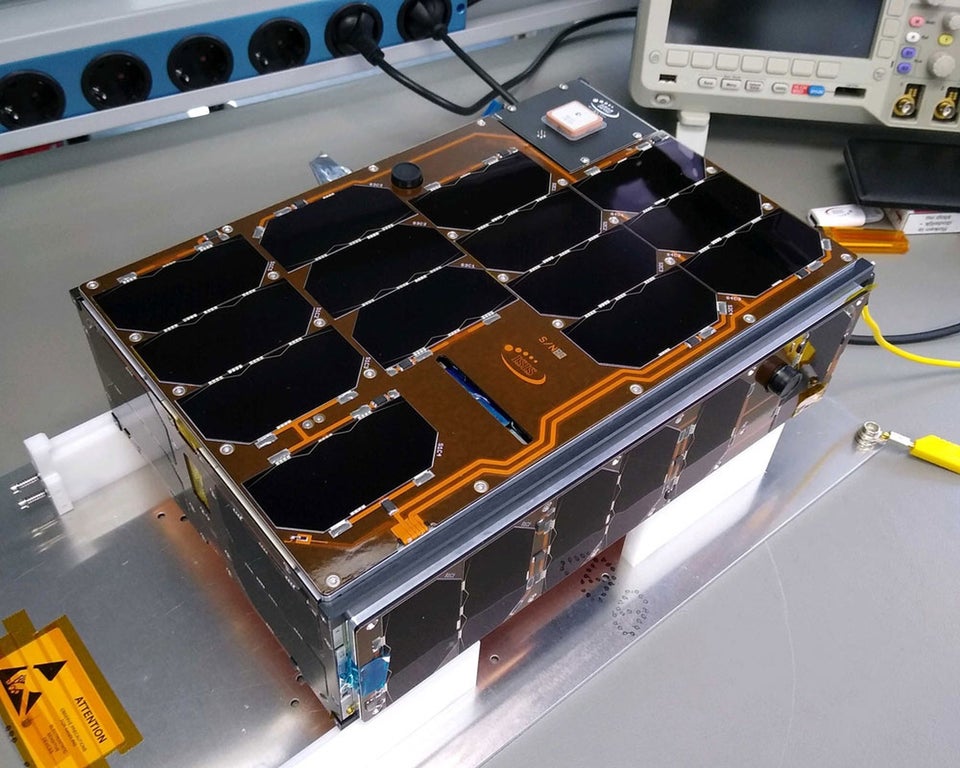
The satellite was built by Innovative Solutions in Space with an almost three million dollar budget, which covered both the research and development as well as launch. Future plans include adding other satellites to the fleet. For the Royal Netherlands Air Force’s purposes, a total of about 24 satellites will be needed.
SatRevolution Payloads
SatRevolution will be launching two satellites called STORK-4 and STORK-5 Marta. In short, these satellites will observe and collect data from far below on the Earth’s surface. Mainly focusing on the United States of America, it will study farmland by collecting data on the condition of crops. This data can then be used by farmers to better the quality and health of their crops and properly regulate their hydration levels.

Both satellites will also help to manage large scale projects like mining and the construction of fiber optic networks. By studying sun and shade angles and coverage, STORK-4 and STORK-5 Marta can help to determine the best and most efficient locations for solar panels to maximize their energy output.
A goal has been stated by SatRevoluation of 1,500 satellites total in the Real-time Earth Observation Constellation (REC) constellation by 2026. Each STORK satellite will have the ability to communicate with each other and process data as well as imagery onboard, to simplify and accelerate the data interpretation process. In addition, Virgin Orbit and SatRevolution recently announced a new partnership where Virgin Orbit will continue to launch more satellites for SatRevolution. The companies will work together to further streamline the small sat buisiness.
LauncherOne Launch Sequence
After Cosmic Girl reached 10,600 m (35,000 ft) of altitude, the pilots pitched the plane upwards at a 27° angle. Then, controllers gave the launch command (hitting the Big Red Button) from the “first-class” Mission Control. This triggered the launch sequence that ensures that there is no accidental jettison prior to the actual commanded launch.
Launch
The red pylon contains 3 hooks that detach from the rocket, letting the rocket fall. After about three seconds of free-fall, the propellant settling thrusters ignited, followed by the NewtonThree engine firing. After a few minutes, it increased its velocity to about 12,870 km/h (~8,000 mph). The first stage then separateed from the second and broke up in the atmosphere following a balistic trajectory.
Stage Separation
Shortly after stage separation, the second stage’s NewtonFour Engine ignited. It propeled the payload the rest of the way to orbit. It then preformed another burn to circularize its orbit. Once the rocket was out of the thickest parts the atmosphere, the fairing halves separated and fell back into the ocean, since they were no longer needed to protect the payload.
LauncherOne
LauncherOne is comprised of two stages. To start off, the first stage, which houses RP-1 (Rocket Propellant-1, a highly refined form of kerosene) and liquid oxygen or LOX. These two will mix and power the single, pump-fed NewtonThree engine, which is capable of producing 327 kN (73,500 lbf) of thrust. Near the fins of the engine, there are two Propellant Settling Thrusters (PSTs). They ignite just seconds before the NewtonThree engine to force the propellants to the bottom of the tank where the valves are, which leads to the propellant transfer lines so the engine doesn’t take in any air. This is not commonly seen on the first stages of liquid-fueled rockets, since they take off vertically and on the ground. However, they are very common and almost necessary on the proceeding stages of any rocket.

The second stage is much smaller and has a single, pump-fed, NewtonFour engine, which is also propelled by RP-1 and LOX. This engine has the capability to relight and can only produce 22 kN (5,000 lbf) of thrust. The difference between each engine is minimal since LauncherOne is already at around 10,600 m when its first stage ignites. Therefore both engines need to have a larger engine bell than if they were at sea level. This larger bell helps to take advantage of the lack of air pressure at high altitudes to perform better.
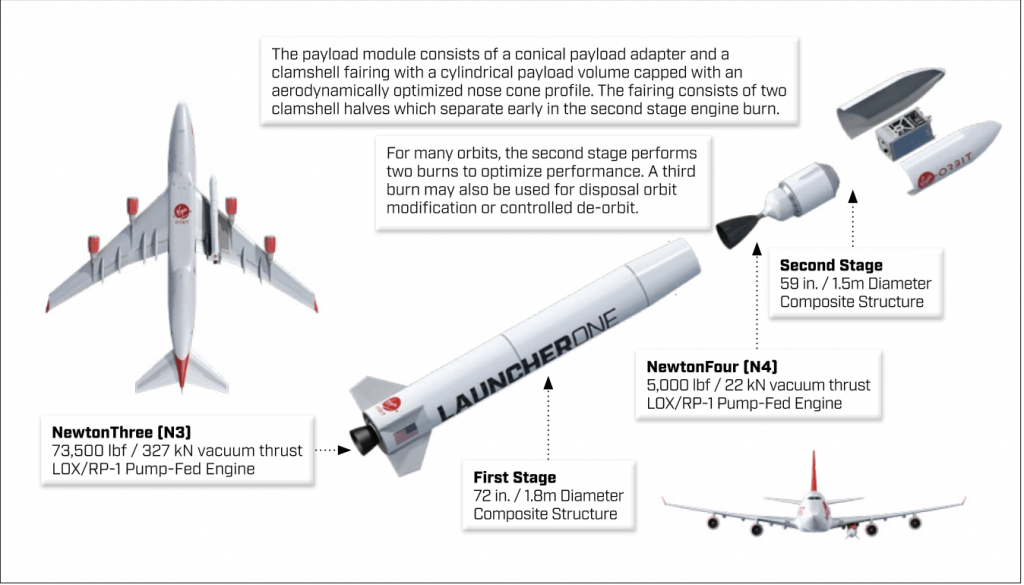
How does LauncherOne compare to other rockets?
The only other place where one might find a set of events similar to LauncherOne’s is Northrop Grumman’s Pegasus launcher, which also starts underneath a plane. In particular, a Lockheed L-1011 TriStar aircraft named Stargazer. Pegasus has launched a total of 44 times with 39 total successes.
How do Pegasus and LauncherOne differ?
Visually, they are both fairly similar. They have the familiar rocket shape (flamey end and a pointy end) and both have fins. However, Pegasus has a wing near the midsection of the rocket. This is for enhanced stability specific to the structure of Pegasus.
| LauncherOne | Pegasus | |
| First Stage Engines | 1 | 1 |
| Stages | 2 | 3 |
| Payload Capacity (LEO) | 500 kg (1100 lb) | 443 kg (977 lb) |
| Launch Platform | Boeing 747-400 (Cosmic Girl) | Lockheed L-1011 TriStar (Stargazer) |
| Lift-off Location | Mojave Air and Spaceport, California | Varies (Florida, California, Pacific and Atlantic Oceans) |
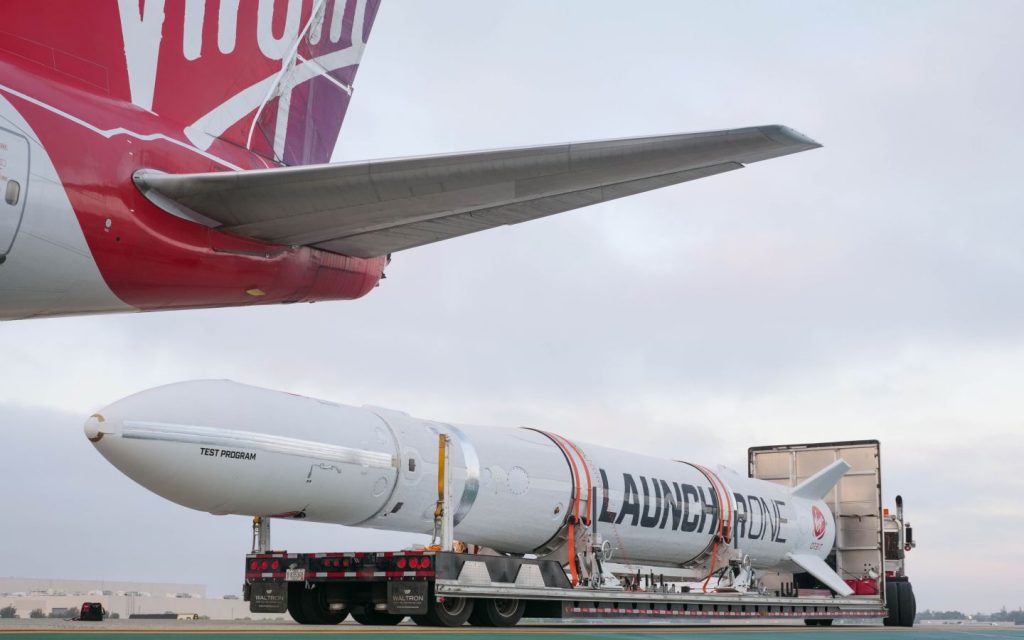
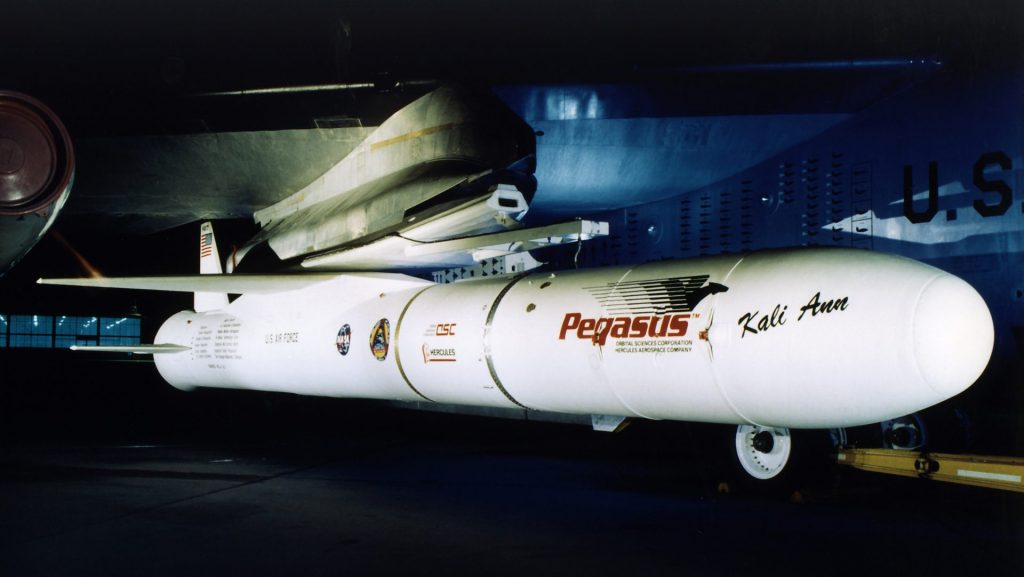
Why Air-Launch?
The ability to air-launch is a tremendous advantage for multiple reasons. If the weather is bad in one area, the plane can fly to another area with calmer skies. Some other advantages include a reduced amount of fuel, an altitude and velocity increase, which will already have taken it out of the denser parts of the atmosphere.
However, there is one major disadvantage. Weight. Because Cosmic Girl can only carry so much weight, and fuel is heavy, Virgin Orbit reduced the payload’s weight. That means the maximum payload to LEO is 500 kg and to Sun Synchronous Orbit (SSO) is 300 kg.

On the other hand, this weight limitation does not impede Virgin Orbit’s principal mission. Their goal is to make space available to everyone. Since the CubeSat industry is expanding, there is room for yet another launch vehicle in the small sat launcher class. They will be capable of providing a cheaper way to launch small satellites for universities and STEM programs.


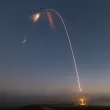
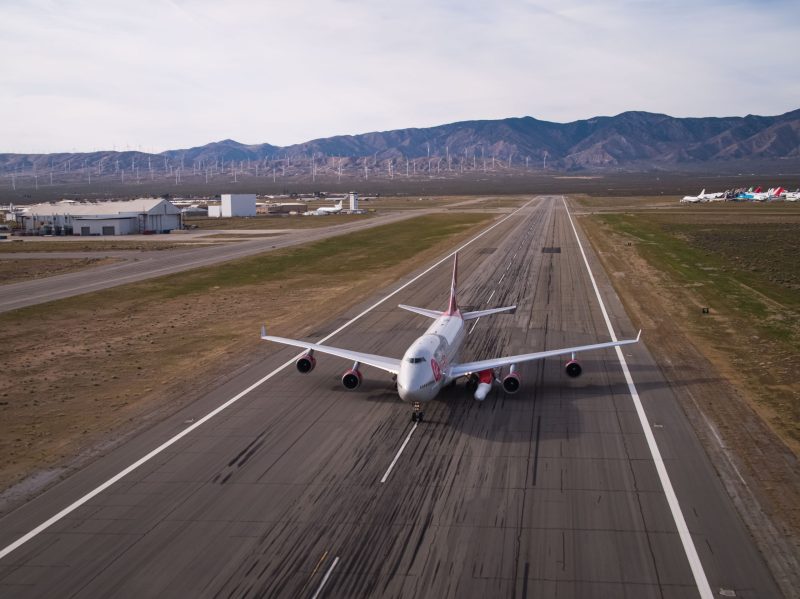
Hello, the “Everyday Astronaut replay” in Where to watch section leads to the wrong livestream.
Hello Damian, Thank you for letting us know. It’s been fixed!